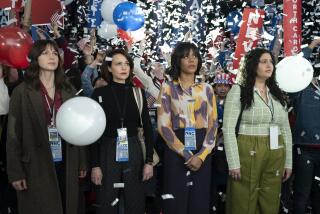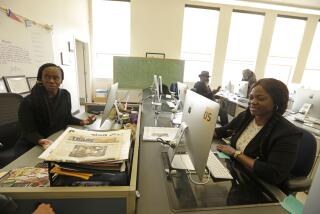Clinton Bypasses Capital Press Corps Via Satellite Technology
WASHINGTON — As the President took his place behind the lectern, one of his aides whispered a small fact to a colleague about the exercise in new technology and politics that was about to begin.
“We’re preempting ‘Studs’ in Fresno,” he said.
So the President would learn shortly.
The Clinton Administration was conducting a new kind of satellite press conference with local reporters in California. But as his staff connected the wires, he suddenly heard the unpresidential sound of local syndicated daytime TV in his earpiece--specifically the voices of three muscular gents trying to win dates with three tightly clad ladies from the show “Studs.”
“This is the hottest, sexiest kiss I’ve ever had,” a voice said.
“What?” Clinton wondered aloud.
“I’m one hot hunk.”
The President blushed.
“You’re hearing their programming, sir,” an aide informed him.
A few minutes later the second local satellite press conference in history began, as part of the Administration’s effort to get beyond the Washington press corps--with the aid of technology--to local reporters around the country.
The Administration has arranged local press conferences in five states--California, Arizona, Louisiana, Wisconsin and Nevada--in which reporters are invited to a television studio to interview the President, just as the White House press corps does.
The President is in a studio, the reporters back home. But they are connected by dual satellite feeds.
Local TV stations and the White House share the costs, and the President gets extensive local coverage, often live, in which dozens of hometown journalists ask questions about any subject they choose.
In Fresno, journalists from San Diego, Los Angeles and San Francisco pressed Clinton on a range of local issues, from agricultural subsidies to the California drought to the Endangered Species Act.
These were not reporters coiffed by professional makeup artists and wrapped in French and English suits. They had come from Madera, Fresno, Bakersfield, Modesto and Salinas, from farm radio stations and local weeklies--in blue jeans, in polyester shirts, in white shoes, in sneakers. Ties were optional.
The idea for the local press conferences came from one of Clinton’s 23-year-old media aides. Audio feeds of the conferences go to the White House press rooms and transcripts are available to national reporters.
On the day Clinton did his press conference in Fresno and Phoenix, one curious trend emerged:
The smaller the news organization, the more policy-oriented the question. The larger the local news organization, the more political the question.
The political reporter from the Arizona Republic, the biggest paper in the state, wanted to know how big a setback it would be for the Administration if the President’s deficit-reduction plan failed in Congress.
“It would be a big setback for America,” Clinton shot back. “They think they’re being tough,” mused Jeff Eller, White House director of Media Affairs. “But those are the easiest questions of all.” Among the harder questions, he said, are those that deal with policy issues that are crucial to a local area.
The reporter from the Sun City Daily News in Sun City, Ariz., where most of the readers are retirees, wanted to know how senior citizens would be helped by Clinton’s budget plan.
Clinton staggered a bit, admitting that “a lot of senior citizens who have their investments in primarily interest-earning accounts have had their earnings drop as interest rates have gone down. . . . I think it will strengthen their investments,” he said vaguely, “by promoting economic growth.”
More to Read
Get the L.A. Times Politics newsletter
Deeply reported insights into legislation, politics and policy from Sacramento, Washington and beyond. In your inbox three times per week.
You may occasionally receive promotional content from the Los Angeles Times.










